Want to know the best way to increase conversions RIGHT NOW?
Improve your value proposition.
Your value proposition is the #1 thing that determines whether people will stay on your website or hit the back button.
If I could give you one piece of business advice, “test your value proposition” would be it.
Which is what we plan to do in this post.
Because if you get it right, it could be a huge boost to your business or blog.
The less your business or blog is known, the stronger the value proposition needs to be. When I review websites, hell even when I visit websites, a missing or poor value proposition statement is the most common shortcoming.
Luckily for you, this is a relatively easy thing to fix.
In today’s post I’m going to break down the following:
- Define a value proposition
- Where you can find it on a webpage
- How to make yours better
- Show you how you can test to see whether your value proposition is clear or not using real people
What is a Value Proposition?
Let’s be honest, developing a value proposition is last thing on your mind when building your website.
You’ve got better things to do like choosing a theme, designing the layout and maybe even setting up your sales funnel.
Creating a solid value proposition is typically the one thing left to the end (which is why most websites are either missing one or have crappy ones).
Writing value props aren’t the most glamorous thing you can do on your website but it is something you’ve got to clearly communicate to your visitors.
The definition of a value proposition is a promise of value to be delivered — often in exchange for something else (like an email if it’s a free item or cash if it’s a product or service being sold).
It’s the primary reason a prospect should buy from you.
Think of your value proposition as the full set of perceived benefits and costs, in the prospect’s mind, of taking your call to action.
It’s every piece of copy and imagery on your homepage, landing page, and sales page. Chris Goward over at WiderFunnel does a good job of illustrating how this perception motivates people to action: 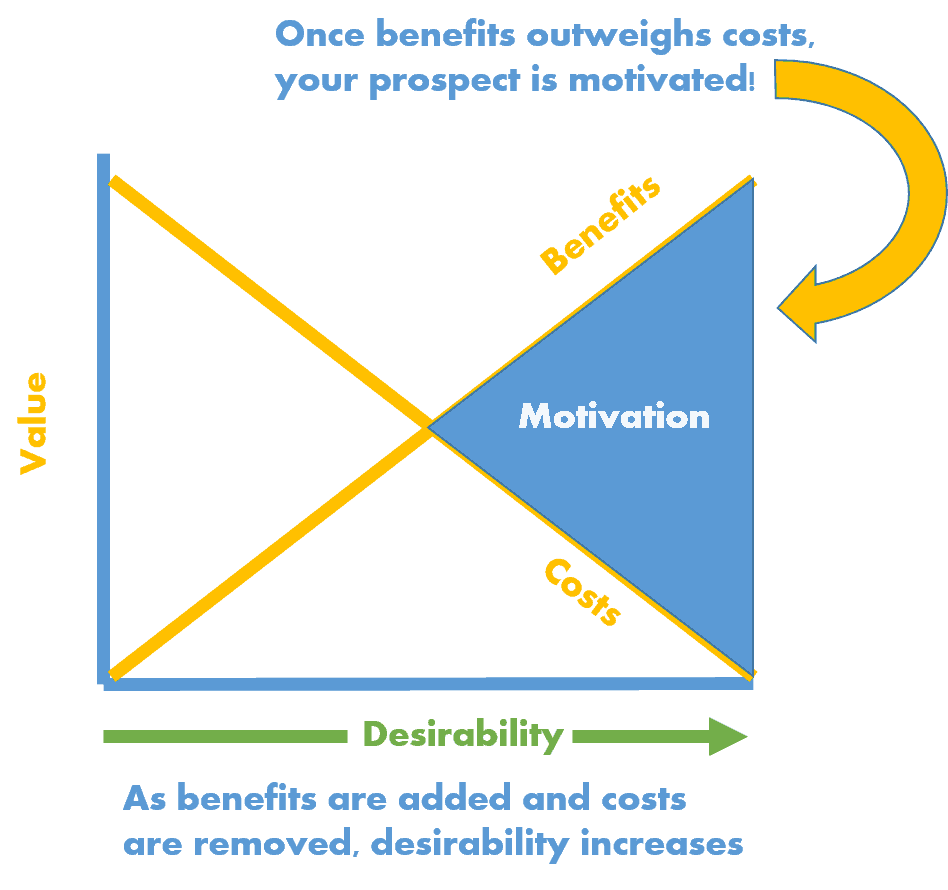 When your perceived benefits outweigh the perceived costs, your prospect will have enough motivation to take action.
When your perceived benefits outweigh the perceived costs, your prospect will have enough motivation to take action.
The word “perceived” is important to note because the perception of your value proposition in your prospect’s mind is influenced by their experiences, temperament and past interactions with you and your competitors.
Not everyone shares the same perception.
For example, your perception of the words value, economy, premium, quality and guarantee may be different than mine.
To some, the words value and economy imply something cheap and low-quality.
To others, those same words say “smart” and “self-disciplined”. The strength of your value proposition determines your potential for an increase in your conversion rate.  If you have a strong value proposition, people will want what you offer.
If you have a strong value proposition, people will want what you offer.
But if they can’t figure out what you’re saying, simply saying it more clearly will motivate more of them to buy.
If your value proposition is weak, or weaker than your competitors, you’ll have a difficult time improving conversion rates no matter how well designed your website and landing pages are.
Clarity of Your Value Proposition
Your value proposition is for people to read and understand.
Two very important words there: read AND understand.
How do you get people to understand your value proposition? Clarity. Clarity is one of the things most people doing business online struggle with.
It seems so simple, right? “Just say what you mean” might appear to be easy but is surprisingly difficult for many to accomplish.
For whatever reason, website owners get caught up in trying to be cute or using jargon that only makes sense to a few people.
Don’t do that.
Learn from a mistake I made on my previous website when I fell victim to writing TLA’s (Three Letter Acronyms).
When I conducted a user testing session, the person attempted to pronounce the three letter word and it sounded ridiculous. #fail Check out this value proposition statement Marketo once had on the homepage of their website:
Revenue-focused marketing automation & sales effectiveness solutions unleash collaboration throughout the revenue cycle
Do you understand what value they are promising? Yeah, me either. Good thing they updated their value proposition to this:
The #1 marketing automation solution for organizations of any size
Now I have a better idea of what it is they offer!
And how many prospects do you think hit the back button during those years that value prop graced the home page? I would venture to guess they missed out on quite a bit of revenue.
Another example is this landing page for a 30-day freelance writing course. The clarity of the offer and promise of value on this page is pretty clear; it’s to learn how to be a successful freelance writer in 30 days or less. 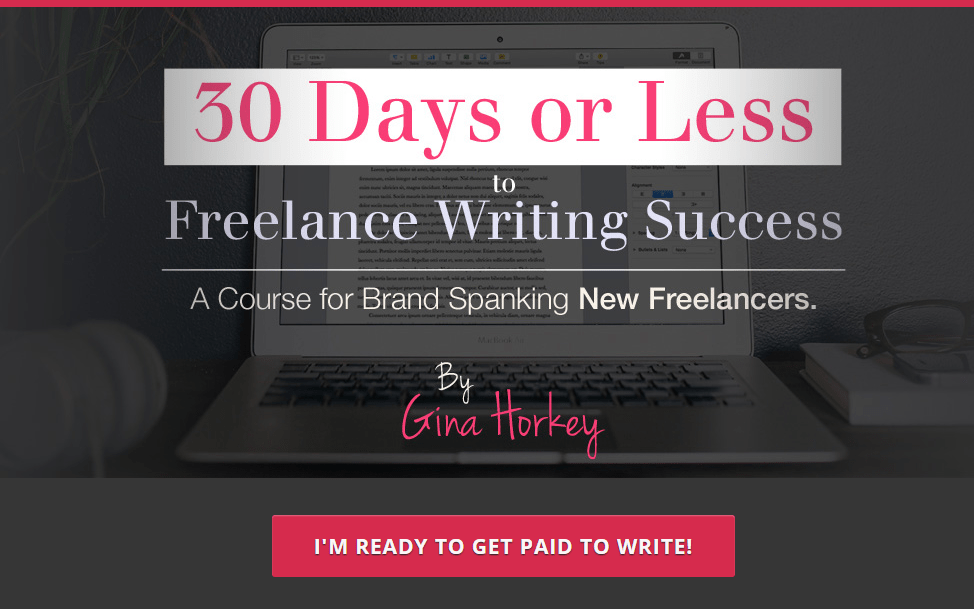 Or this example from Campaign Monitor. Their homepage states the exact promise of value to be delivered, “Elegantly simple email marketing”.
Or this example from Campaign Monitor. Their homepage states the exact promise of value to be delivered, “Elegantly simple email marketing”. 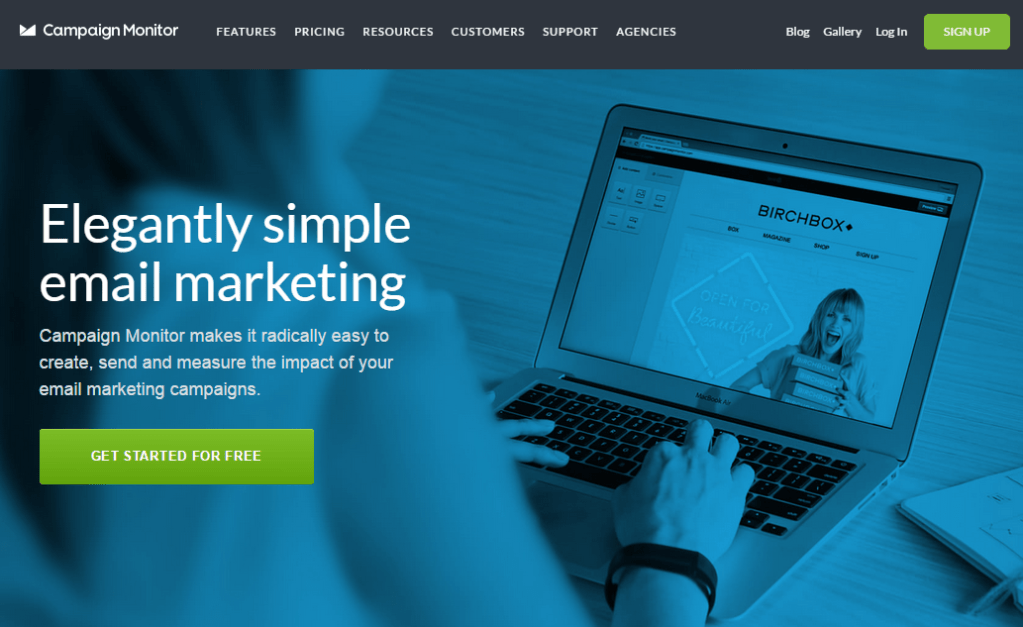 When you communicate clearly, it makes it easy for the visitor to understand what it is you offer and whether or not they should stay on your site.
When you communicate clearly, it makes it easy for the visitor to understand what it is you offer and whether or not they should stay on your site.
Clarity is not limited to the copy on your site.
It is also related to the imagery that compliments the words on each page.
This is called content clarity. When your content is clear, your imagery and copywriting compliment each other. They work together to reinforce your value proposition and guide the prospect to take the call to action.
Attributes of a Value Proposition
So what exactly makes up a value proposition? Unbounce has a great framework from which to work from when creating a landing page and we’ll use a few of the attributes they mention.
I’ve created a variation of the landing page they use in their example for you to refer to below (click to enlarge). 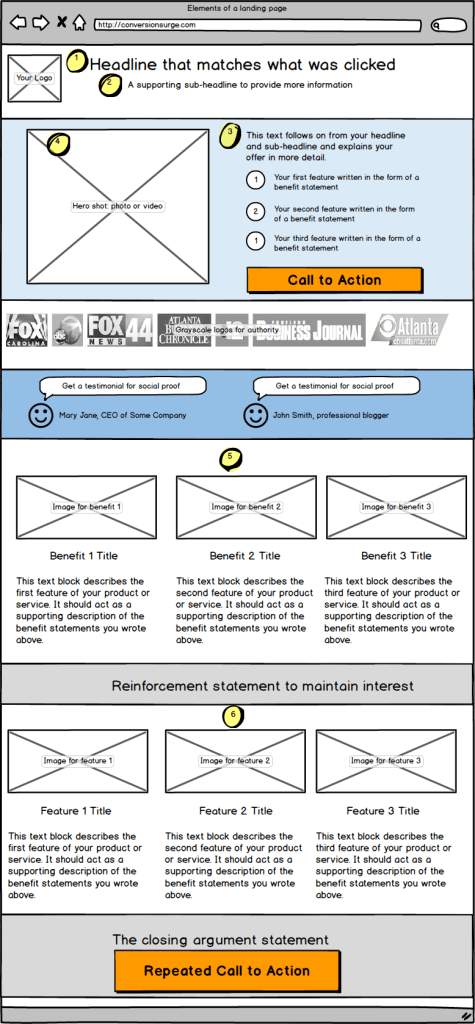 Your value proposition should consist of the following:
Your value proposition should consist of the following:
- The main headline
- A supporting subheadline
- Minimum of three bullet points explaining features as benefits Image of product or service – either of the product itself or context of use
- Detailed section of features (optional)
The main headline  Your headline is the very first thing people will see and read. It’s critical it clearly describes what a visitor will get from the page (its goal), and the message match is strong enough to show the visitor they are in the right place (relevancy).
Your headline is the very first thing people will see and read. It’s critical it clearly describes what a visitor will get from the page (its goal), and the message match is strong enough to show the visitor they are in the right place (relevancy).
A supporting sub-headline  Your headline should be short and be able to capture the attention of the visitor.
Your headline should be short and be able to capture the attention of the visitor.
The best way to keep your headline short and sweet is to add a supporting headline.
To create a supporting headline, you can: Use it as a direct extension of the headline, where it follows the primary headline in such a way it’s like finishing a sentence.
Use it to extend the message by applying an additional persuasive messaging to support the primary one. Bullet points to explain features/benefits 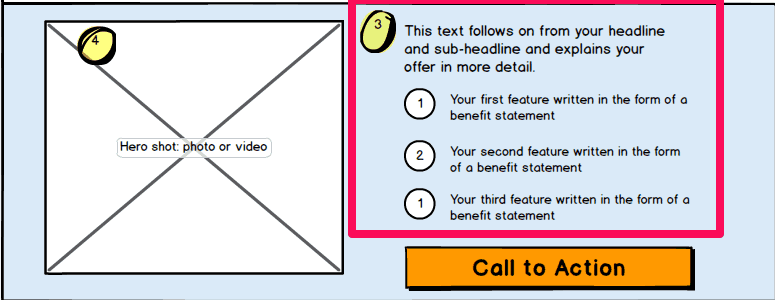 Write at least three bullet points explaining the features of your product or service expressed as a benefit.
Write at least three bullet points explaining the features of your product or service expressed as a benefit.
Think of the pain points you are solving for your prospect and tell them why what you are offering is useful and how they can benefit from it. Be careful not to use too much text here as you want these to be easily scanned by your prospect.
Again, be super clear and concise, so people know exactly what it is you’re offering. A couple of examples of a value proposition:
-
-
- For a phone… Bad (feature based) Our new battery is twice as powerful as the competition. Better (benefit based) Our new battery means you’ll only need to charge your phone every couple of days.
- Or… For a microwave: “Saves you hours every week by heating up your food faster than a conventional oven”. As opposed to a feature such as “Heats up food”.
-
Image of product or service  The image (or hero shot) is the best photograph or graphical image of your product or service, designed to make it stand out as something worth attaining.
The image (or hero shot) is the best photograph or graphical image of your product or service, designed to make it stand out as something worth attaining.
Make it big, make it beautiful.
This should go without saying: use a good camera with high resolution and a neutral background. There’s another element of successful hero shots called context of use.
This is the idea of showing your product or service in real-life action. Look at how Styler uses context of use to let prospects know how good they will look if they sign up for their service.  Other ways you can do this based on the type of product or service you are promoting are:
Other ways you can do this based on the type of product or service you are promoting are:
- Online service: video demo/screencast
- Physical product: video of the product being used for it’s intended purpose
- Ebook: a preview of a portion of the content as proof of its value
Here’s a great example of context of use – the ShamWow infomercial. Chessy? Yes. Super clear and specific? For sure. And it’s entertaining. Check it out:
If you have people asking a lot of questions about the use of your product or what it is you do, create a quick two-minute video to explain.
A recent study by eyeView Digital shows video can increase conversions on landing pages by up to 80%. You should test what adding a video can do for you.
Detailed section of benefits and features  I labeled these sections optional for a couple of reasons.
I labeled these sections optional for a couple of reasons.
With more and more companies like LeadPages offering landing page and home page software that lets you quickly build pages from templates, some of the templates might not be designed to have this section.
The second reason is depending on what it is you are offering; you might not need this much copy on your page. If it’s an eBook or white paper, it wouldn’t make sense to go into such detail over the exchange of an email address.
When it comes to writing copy, how much copy you need depends on the product or service you are offering. I like to think of this copywriting principle:
Copy is like a woman’s skirt. It should be long enough to cover the essentials and short enough to keep it interesting
If you do end up writing detailed features and benefits, just extend the bullet points into a more detailed overview of their purpose and benefit.
A good way to approach this is to expand the benefits first, and then if needed, add some feature details below. The important point to remember here is you need to communicate the benefit of your offering first.
Then, and only then, do you start to add features – which are typically directed towards those who require more detail to make a decision.
You’ll want to include imagery in this section to show how each feature will look when being used, such as screenshots, where applicable. Alternatively, you can use icons to represent the features.
How to Craft and Test Your Value Prop
According to Anthony Tjan, author of Heart, Smarts, Guts, and Luck, there are only four types of consumer benefits that matter and by extension only four categories of value propositions that work.
Therefore, you’ll want to see if you can group your offering into one of these four categories:
- Best quality
- Best bang for the buck
- Luxury and aspiration
- Must-have
Once you have determined where you want to be, you will want to focus on your points of difference because differentiation is key.
After all, you want to stand out from your competition right?
Your value proposition includes many features, benefits, and attributes. You couldn’t possibly explain everything in every advertisement, homepage or landing page.
Doing so would overwhelm your visitors and be unnecessary. You’ll need to focus and prioritize your message.
It may seem obvious your most important features and benefits are those that are most important to your prospects and customers, but many people tend to emphasize the features most recently added or were most difficult to add.
To find the most important attributes of your products and services, you should look at your points of parity and points of difference from your prospect’s perspective.  Your points of parity (POPs) are not only the important features you offer to your prospects but are also shared by your competitors.
Your points of parity (POPs) are not only the important features you offer to your prospects but are also shared by your competitors.
Think of them as basic entry requirements to the game.
Your prospect needs to know you offer POPs, but emphasizing them won’t impress anyone. Your points of difference (PODs) are where you can win the game.
They’re the features important to your prospects but are not available with your competitors.
These are the features you can emphasize to move your prospects to action. They are your differentiators.
Differentiators to get you started
So what makes your different than everyone else out there? Do you offer free shipping? Free bonus with a purchase? Most importantly, does your prospect want it?
Ask yourself this question: “Why should my ideal prospect (the group you intend to serve) buy from me instead of a competitor?” If you need a little boost, here’s a list of differentiators to help get the creative juices going: 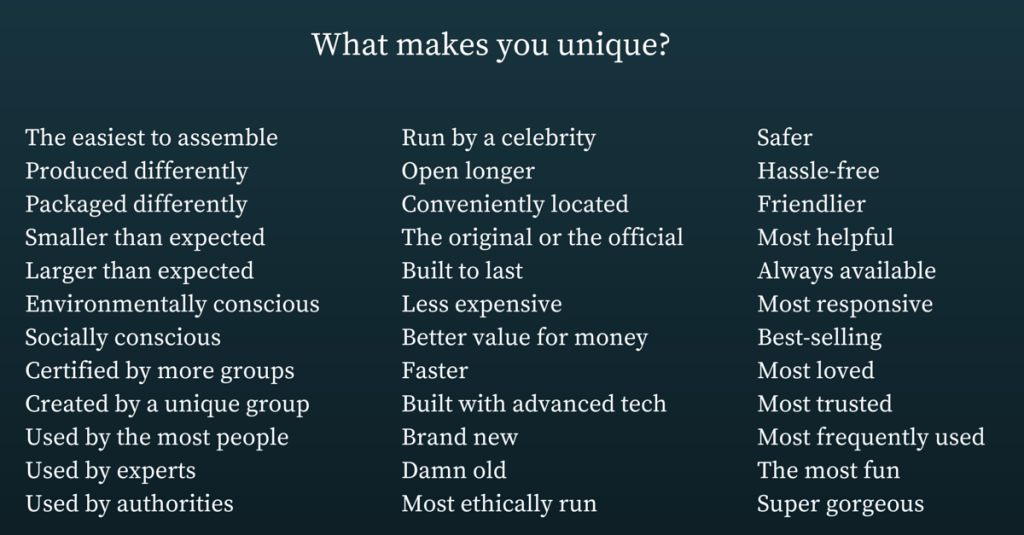 Now, compare your answer with the claims of your main competitors. Go check out their home page, sales page or a landing page if you have a link to one.
Now, compare your answer with the claims of your main competitors. Go check out their home page, sales page or a landing page if you have a link to one.
How do you stack up?
Next, refine your value proposition until you can articulate it in a single, instantly credible, sentence. This is your main headline. Put it there.
If you had just 10 words with which to describe why people should buy from your company instead of someone else, what would you communicate?
These are your features described in the form of a benefit. You can use these as your sub-headline as shown in the landing page example above and/or as material for your three main bullet points.
Use your customer’s language
Greg Ciotti over at Help Scout recently wrote: “Catch-all language is the antithesis of communicating value.”
Truer words have never been spoken. Write your copy around the desires and outcomes you expect to hear from your customers.
Then, revise the copy around the desires and outcomes you actually hear from your customers. You want potential customers to think you are reading their mind.
There really is no getting around this step. You’ve got to talk to your customers to learn how they speak about their problems. Don’t have any customers yet?
One of my favorite methods of using your customer’s language is doing the “Amazon review hack”. It’s one of the methods I teach in creating an irresistible call to action.
Here’s how you do it:
Step 1a: If it’s a service you offer, search Amazon for books about the service you provide. Start reading the reviews and look for keywords and phrases that stand out to you.
Alter them to fit your service and use it as copy on your website.
Joanna Wiebe changed the headline of a rehab center using this method and it brought in 26% more leads.
Step 1b: If it’s a product you offer, search for competitor’s products and read reviews — both good and bad.
Use the good reviews to help you come up with ideas on how to write your features.
Use the bad reviews to write about the benefits of your product (how you relieve the customer’s pain).
Step 2: Weave in your differentiators to give you a boost
You need to test your value prop
With the hard work out of the way, it’s time to have some fun.
Let’s see if your new value proposition is written clearly enough for people to understand what it’s about in 5 seconds (about the time it takes for someone to determine if they want to stay on your website).
The great thing about what you’re about to do is that it doesn’t require you to change anything on your website.
We’re simply testing to make sure the message is clearly articulated.
For FREE.
Step 1: Create a new Google Document and write the following:
- Your new headline
- The sub-headline
- Three bullet points An image of the product/service or context of use
Step 2: Get a shareable URL by clicking the blue share button  Step 3: Click “get shareable link” and leave the settings on “Anyone with the link can view”
Step 3: Click “get shareable link” and leave the settings on “Anyone with the link can view”  Step 4: Navigate to http://usabilityhub.com Step 5: Click “Plans and Signup”
Step 4: Navigate to http://usabilityhub.com Step 5: Click “Plans and Signup”  Step 6: Click “Join the Community”
Step 6: Click “Join the Community”  Step 7: Create your account Step 8: Create a new test
Step 7: Create your account Step 8: Create a new test  Step 9: Click “Create a Five Second Test”
Step 9: Click “Create a Five Second Test” 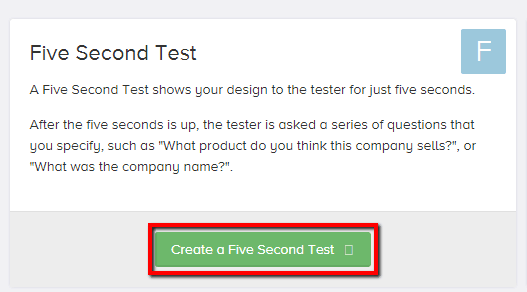 Step 10: Select “Screen Capture a Web Page”
Step 10: Select “Screen Capture a Web Page”  Step 11: Paste your Google Document link and then click “Make a screenshot” Step 12: Enter your test instructions Step 13: Select the question “What do you think this page was about?”
Step 11: Paste your Google Document link and then click “Make a screenshot” Step 12: Enter your test instructions Step 13: Select the question “What do you think this page was about?”  Step 14: Click create test You might need some karma points and have to take a few five second tests yourself but it will get you 20 responses for free.
Step 14: Click create test You might need some karma points and have to take a few five second tests yourself but it will get you 20 responses for free.
Or, you can purchase responses if you don’t feel like taking the time to do the tests.
I recently ran a 5 second test on the home page of conversionsurge.com to see if my value proposition was articulated clearly.
Below is a word cloud of the responses to the question “What you think this page was about?” 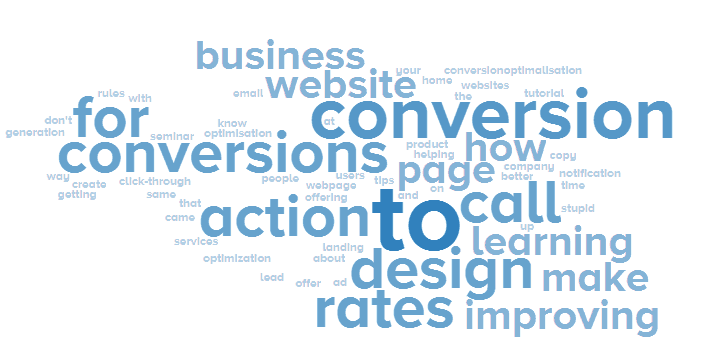 As you can see word like “conversion” and “call to action” stood out during the five second test.
As you can see word like “conversion” and “call to action” stood out during the five second test.
You can see the results here.
It would appear visitors to my site understand the offer of helping them create a better call to action. Could it still be improved? Certainly.
But at least I know I am on the right track. Your word cloud should directly correlate to you value proposition. Does it?
You can even take it a step further and write a question of your own for your five second test. Once you have tested your new value prop is clearly understood.
It’s time to make the change on your website and A/B test. Yes, we are going live and making changes to your webpage.

